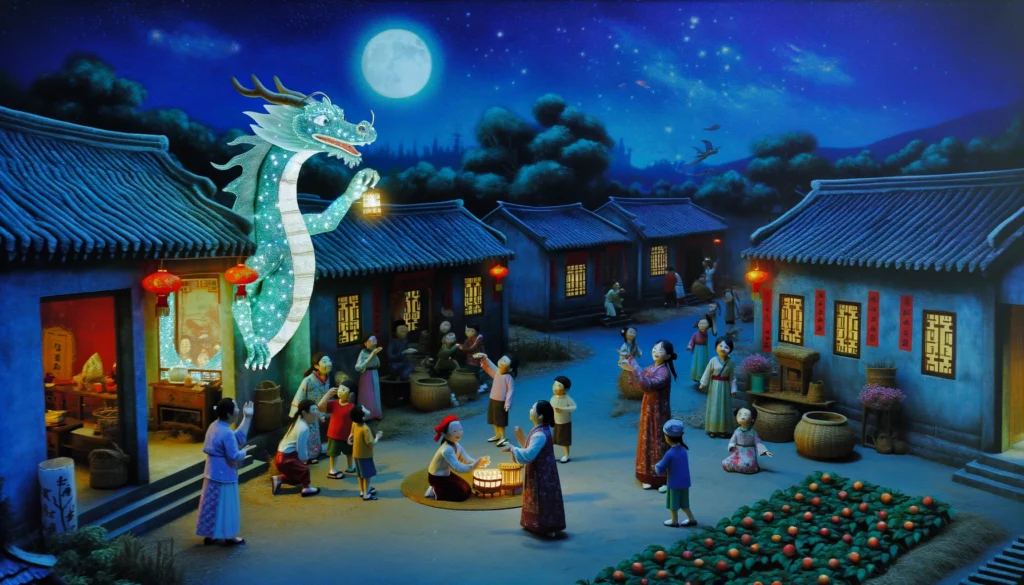This is a free A2 pre-intermediate level English reading lesson about the Year of the Dragon. It includes the reading and reading comprehension exercises in 4 different formats together with the answer keys and explanations.

 Share via Google Classroom
Share via Google Classroom

Long ago, in a small village, there lived a kind dragon. Every twelve years, when his special year came, he visited the people. The dragon’s skin shone like many bright stars. He brought good luck and gifts to all. The villagers loved the year of the dragon. Children played, and families smiled during that time.
The dragon watched over the crops and houses. He made sure everyone was safe and happy. The villagers gave him fruits and sang songs. They danced in the streets under the moon. The dragon’s eyes twinkled as he watched them.
When the year ended, he promised to return. The people always remembered the dragon’s kindness. They told stories of his magic all year round. The year of the dragon was special for everyone.
General Level: A2.0 (excluding the word “dragon”)
Vocabulary: A1.9
Verb Forms: A1.1
Sentences: A2.5
dragon NOUN C2
Definition (En):
villager NOUN C1
Definition (En):
crop NOUN B1
Definition (En):
kindness NOUN B1
Definition (En):
shine VERB B1
Definition (En):
bright ADJ A2
Definition (En):
gift NOUN A2
Definition (En):
kind ADJ A2
Definition (En):
luck NOUN A2
Definition (En):
magic NOUN A2
Definition (En):
PHRASE | COUNT | SENTENCES |
all year round | 1 |
|
good luck | 1 |
|
in the street | 1 |
|
1. What did the dragon bring to the village?
A) Trouble to the people
B) Stars from the sky
C) Good luck and gifts
D) New songs to sing
2. How did the villagers feel about the dragon’s yearly visit?
A) They were scared
B) They were unhappy
C) They loved it
D) They ignored it
3. What did the dragon do for the village?
A) He played with the children
B) He watched over crops and houses
C) He told stories
D) He drew pictures
4. Why did the villagers give fruits to the dragon?
A) To make him go away
B) Because it was a tradition
C) As a sign of fear
D) To thank him
5. What happened when the dragon’s special year was over?
A) The dragon stayed in the village
B) The dragon promised to return
C) All the gifts disappeared
D) The crops failed
6. How often did the dragon visit the village?
A) Every year
B) Every twelve years
C) When he wanted
D) During the harvest
7. What time of day did the village activities take place?
A) In the morning
B) In the afternoon
C) Under the moon
D) At sunrise
8. Why did the children play and families smile during the dragon’s year?
A) Because they had no work
B) Because of the dragon’s special visit
C) Because it was a holiday
D) Because they received money
1. How often did the dragon visit the village?What did the dragon’s skin look like?
2. What did the dragon bring to the villagers?
3. Did the villagers feel afraid or happy during the year of the dragon?
4. What did the dragon do for the crops and houses?
5. Why did the villagers give fruits to the dragon?
6. What did the dragon promise at the end of the year?
7. How did the villagers show their happiness?
8. What did the dragon feel as he watched the villager
9. Was the year of the dragon forgotten by the people after it ended?
Long ago, in a small village, there lived a kind dragon. Every twelve years, when his special year came, he visited the people. The dragon’s skin shone like many ___1___. He brought ___2___ luck and gifts to all. The villagers loved the year of the dragon. Children ___3___, and families smiled during that time.
The dragon watched over the ___4___ and houses. He made sure everyone was ___5___ and happy. The villagers gave him fruits and sang ___6___. They danced in the streets under the ___7___. The dragon’s eyes twinkled as he watched them.
When the year ended, he promised to ___8___. The people always remembered the dragon’s ___9___. They told stories of his magic all ___10___ round. The year of the dragon was special for everyone.
1) A. bright stars B. dark clouds C. cold snow D. hot sun
2) A. bad B. good C. no D. every
3) A. ran B. played C. worked D. slept
4) A. rivers B. mountains C. crops D. forests
5) A. tired B. sad C. safe D. angry
6) A. whispers B. screams C. songs D. silence
7) A. sun B. moon C. stars D. clouds
8) A. leave B. sleep C. return D. forget
9) A. strength B. kindness C. speed D. color
10) A. day B. week C. month D. year
Explanation: The text says the dragon lived in the village, not far away from it.
(“Long ago, in a small village, there lived a kind dragon.”)
Explanation: The dragon visited the villagers every twelve years, not just once.
(“Every twelve years, when his special year came, he visited the people.”)
Explanation: The dragon’s skin is described as shining like bright stars, which means it wasn’t dull.
(“The dragon’s skin shone like many bright stars.”)
Explanation: The text indicates that the dragon brought good luck and gifts and was loved, not feared, by the villagers.
(“He brought good luck and gifts to all. The villagers loved the year of the dragon.”)
Explanation: Since the villagers gave the dragon fruits and sang to him, they did care for him.
(“The villagers gave him fruits and sang songs.”)
Explanation: The dragon’s twinkle in his eyes suggests he enjoyed the villagers’ dancing and singing.
(“The dragon’s eyes twinkled as he watched them.”)
Explanation: People danced in the streets under the moon, implying that the dragon visited at night as well.
(“They danced in the streets under the moon.”)
Explanation: The text clearly states that the dragon promised to return, which shows he did make a promise.
(“When the year ended, he promised to return.”)
Explanation: The people remembered the dragon’s kindness, not mean actions.
(“The people always remembered the dragon’s kindness.”)
Explanation: The year of the dragon was described as special for everyone, meaning it was not ordinary.
(“The year of the dragon was special for everyone.”)
Explanation: The text directly states that the dragon brought good luck and gifts to everyone.
(“He brought good luck and gifts to all.”)
Explanation: The text says the villagers loved the year of the dragon, which implies they had positive feelings.
(“The villagers loved the year of the dragon.”)
Explanation: As per the text, the dragon’s role was to watch over the crops and houses.
(“The dragon watched over the crops and houses.”)
Explanation: Giving fruits and singing songs to the dragon are actions of gratitude, thanking the dragon.
(“The villagers gave him fruits and sang songs.”)
Explanation: The text states that the dragon promised to come back after the special year ended.
(“When the year ended, he promised to return.”)
Explanation: The text specifies that the dragon visited every twelve years.
(“Every twelve years, when his special year came, he visited the people.”)
Explanation: According to the text, villagers danced under the moon, indicating nighttime activities.
(“They danced in the streets under the moon.”)
Explanation: This refers to the joy caused by the dragon’s special visit, as it’s stated ‘Children played, and families smiled during that time.’
(“Children played, and families smiled during that time.”)
1. Every twelve years.
Explanation: The text directly states that the dragon visited the village every twelve years.
(“Every twelve years, when his special year came, he visited the people.”)
2. Like many bright stars.
Explanation: The text compares the dragon’s skin to the shine of many bright stars.
(“The dragon’s skin shone like many bright stars.”)
3. Good luck and gifts.
Explanation: The text states that the dragon brought two things to the villagers: good luck and gifts.
(“He brought good luck and gifts to all.”)
4. Happy.
Explanation: The text mentions that children played and families smiled, indicating that they were happy.
(“The villagers loved the year of the dragon. Children played, and families smiled during that time.”)
5. Watched over them.
Explanation: The text states that he kept an eye on the crops and houses, meaning he watched over them.
(“The dragon watched over the crops and houses.”)
6. As a gift.
Explanation: The text suggests that giving fruits was a way to show gratitude and to offer a gift to the dragon.
(“The villagers gave him fruits and sang songs.”)
7. To return.
Explanation: The text explicitly states the dragon’s promise to come back when the year ended.
(“When the year ended, he promised to return.”)
8. They danced in the streets.
Explanation: The text describes the villagers dancing in the streets which shows their happiness.
(“They danced in the streets under the moon.”)
9. His eyes twinkled.
Explanation: The twinkling of the dragon’s eyes suggests a positive emotion as he observed the villagers.
(“The dragon’s eyes twinkled as he watched them.”)
10. No.
Explanation: The text says the people always remembered the dragon’s kindness, meaning they did not forget about the year of the dragon.
(“The people always remembered the dragon’s kindness.”)
1. A
Explanation: The text describes the dragon’s skin glowing like ‘bright stars’.
2. B
Explanation: The dragon brought ‘good’ luck, as indicated by the context.
3. B
Explanation: The text says children ‘played’, which shows enjoyment and activity.
4. C
Explanation: The dragon watched over the ‘crops’, which relate to farming and food.
5. C
Explanation: The dragon ensured everyone was ‘safe’, which is the opposite of danger.
6. C
Explanation: The context implies a joyful activity; therefore, villagers sang ‘songs’.
7. B
Explanation: They danced at night, so it was under the ‘moon’.
8. C
Explanation: The dragon said he would ‘return’, promising to come back.
9. B
Explanation: The village remembered the dragon for his ‘kindness’.
10. D
Explanation: The phrase ‘all year round’ suggests throughout the entire ‘year’.
On Cathoven, you can create readings and exercises tailored to specific vocabulary, grammar points, and proficiency levels, all within minutes.

© 2025 Cathoven AI | All rights reserved